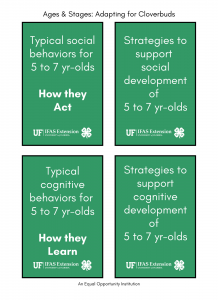 In a recent study, one of the top things 4-H volunteers are looking for are ideas for adapting activities to different age groups (Kent, 2022). Florida 4-H offers experiences for four different age groups: Cloverbuds (ages 5-7), Juniors (ages 8-10), Intermediates (ages 11-13) and Seniors (ages 14-18). 4-H encourages family involvement and engagement, and volunteers often find themselves working with a variety of age groups. Each of these age groups have unique needs related to their social and cognitive development. Over the next few weeks, our blog will provide tips and ideas for adapting 4-H curriculum and activities to meet these needs.
In a recent study, one of the top things 4-H volunteers are looking for are ideas for adapting activities to different age groups (Kent, 2022). Florida 4-H offers experiences for four different age groups: Cloverbuds (ages 5-7), Juniors (ages 8-10), Intermediates (ages 11-13) and Seniors (ages 14-18). 4-H encourages family involvement and engagement, and volunteers often find themselves working with a variety of age groups. Each of these age groups have unique needs related to their social and cognitive development. Over the next few weeks, our blog will provide tips and ideas for adapting 4-H curriculum and activities to meet these needs.
What are “Ages & Stages” and Why Does it Matter?
“Ages & stages” is a phrase commonly used in youth development that refers to the physical, social, emotional, and cognitive development of a young person. These categories of development are based on the work of researchers such as Piaget and Erickson. Understanding these categories help 4-H volunteers and professionals provide opportunities for youth to thrive through social and emotional learning and is a key part of the 4-H Thrive Model (Arnold & Gagnon, 2020). There are several benefits of selecting (or adapting) age-appropriate activities for youth:
- First, it makes learning fun! Fun is important; boring is bad.
- Youth are more engaged. When activities are not too challenging or too easy, they are in what’s called the “zone of proximal development,” or ZPD (Vygotsky, 1978). This is key to helping learners master new skills. ZPD refers to skills or knowledge that are too difficult for a cloverbud to master on their own, but possible to master with guidance from a more knowledgeable person- like their 4-H volunteer!
- Youth can build on past learning experiences and create future opportunities to grow.
- When learning is fun and youth are engaged, youth stay involved in 4-H!
How to Use “Ages & Stages” to help Cloverbuds Thrive
Social Development of 5-7-year-olds (how they act)
Youth who are 5-7 years old are learning how to develop their own initiative. Giving them opportunities to initiate activities and learn from others is important. Instead of telling them what to do every time, provide them with a chance to ask questions and develop initiative- when they do, be sure to recognize their efforts and encourage them.
| Typical social behaviors for 5-7-year-olds include: | Strategies for supporting social development of 5-7-year-olds: |
|
|
Cognitive Development of 5-7-year-olds (how they think)
Youth who are 5-7 years old are usually still egocentric- that means they typically think about things only from their personal point of view. They like to use symbols in play, and want to define and classify things by how they are used. It is hard for them to understand cause and effect relationships, and have difficulty multi-tasking.
| Typical learning behaviors for 5-7-year olds include: | Strategies for Supporting Cognitive Development of 5-7-year-olds: |
|
|
Examples of Adapting Activities for Cloverbuds. Throughout this series, we have been using examples from each of the three pillar programs in 4-H: Citizenship & Leadership, Science, and Healthy Living. These examples are meant to help parents and volunteers see how an activity can be adapted for each of the different age groups. For examples for other age groups, check out our posts about Juniors, Intermediates, and Seniors.
- Citizenship & Leadership: For citizenship & leadership, we have been using the example of a 4-H club business meeting. Five to 7 year-olds aren’t ready to serve in an executive leadership position. However, they can do things like lead the American and 4-H Pledges. They can also contribute ideas to help plan the club calendar. If you have a large number of Cloverbuds in your club, you will want to keep the business meeting short!
- Science: For science, we have been using the 4-H entomology project as an example. Entomology is the study of insects. Youth in the Cloverbud age range really enjoy categorizing and sorting things, so insect ID can be a fun way for them to engage. However, keep the categories simple; instead of handing them a dichotomous guide (that they probably can’t read). Ask them to identify insects with wings vs insects without wings. Or insects with different types of mouthparts, after explaining what the five basic mouthparts are.
- Healthy Living: For Healthy Living, we have been using the 4-H personal wellness project as an example. This project area helps youth learn about nutrition, physical fitness, and mental health. For Cloverbuds, exposing them to different types of fruits and vegetables is a fun way for them to learn about nutrition. For example, you could do a taste test of different types of apples and have them vote for their favorite. This age group would also enjoy growing some of their own food- so think about growing different types of lettuce (which grows quickly in the cooler months in Florida) or cucumbers in the hotter months.
Spending some time thinking about 4-H activities through the “Ages & Stages” lens reinforces the Essential Elements of 4-H: Belonging, Mastery, Independence, and Generosity. They are also key to helping youth thrive. However, each individual youth grows at their own pace and might not completely meet the general tendencies listed above. As volunteers and 4-H professionals, it is important to observe youth and meet them where they are physically sociality, and intellectually. Adapting activities on the fly gets easier with practice- download this set of flashcards for a quick reference guide. You can print them, cut them out, and punch them to fit on a lanyard as a handy teaching aid. Your local 4-H agent is always available to help and provide additional resources if you have questions.
References:
Arnold, M. E. & Gagnon, R. J. (2020). Positive youth development theory in practice: An update on the 4-H Thriving Model. Journal of Youth Development, 15(6), 1-23.
Erikson, E. H. (1963). Childhood and Society (2nd Ed.). New York: Norton.
Kent, H.C. (2022). Informal learning to support volunteer performance. [Unpublished doctoral dissertation]. Florida State University.
Lee, F. and Go, C. (2002). Developmental stages. UC ANR 4-H Youth Development Program.
Piaget, J. (1971). The theory of stages in cognitive development. In D. R. Green, M. P. Ford, & G. B. Flamer, Measurement and Piaget. McGraw-Hill.
Pleskac, S. (2000). Educational design and delivery: Use of age-appropriate activities. VRKC fact sheet.
Vygotsky, L. S. (1978). Mind in society: The development of higher psychological processes. Cambridge, MA: Harvard University Press.
- Meet our Summer Intern- Andy Franklin! - June 13, 2025
- Blue Ribbon Baked Goods - September 23, 2024
- Blue Ribbon Photos and Posters - September 21, 2024

